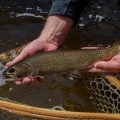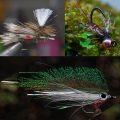How to Tie Devin Olsen’s Blowtorch
Tier and videographer Tim Flagler:
“Devin Olsen’s Blow Torch is a super tasty little fly in the oh-so-popular Euro nymph/competition genre.
For a hook, I’m going to start with a Fulling Mill Jig Force in size 14. I’ll pair this with a copper 7/64” slotted tungsten bead. Insert the hook point into the small hole of the bead and work it up onto the shank. Get the assembly firmly secured in the jaws of your tying vise and seat the bead properly behind the hook eye.
.015 lead-free wire is used to weight the fly and stabilize the bead. While holding the bitter end, take 7 or 8 touching wraps with the wire up the hook shank then helicopter to break the excess off close. Leave some space between the wraps and the bead. A small drop of superglue, here Fly Tyer’s Z-ment, applied to the shank before the wraps are slid forward, really helps to keep the bead locked into place. This also allows you to tuck in that pesky little tag end of wire, without the wraps spinning on the shank.
For thread, I’ve loaded a bobbin with a spool of UTC 70 Denier in fluorescent fire orange. Get the thread started on the hook shank behind the wire and take a few wraps rearward before snipping off the tag.
For the fly’s tail or tag, I’m going to go with Antron yarn, also in fluorescent fire orange, a 5” length will make numerous flies. Secure one end of the yarn to the top of the hook shank and take thread wraps rearward to the start of the bend then forward and up over the wire wraps. When you’re done, snip the excess Antron off close behind the bead. Take wraps of tying thread rearward, once again, back to the start of the bend. While gripping the yarn tight, snip it off even with the rear edge of the hook bend.
To rib the fly, I’m going to use green Sulky Holoshimme. A 10” length makes for easy handling and is enough to tie numerous flies. Lay the Sulky against the near side of the hook and take a few thread wraps to lightly secure it. Pull the Sulky under the wraps so the tag end needn’t be trimmed. Then take a few more thread wraps to make sure it’s bound down well.
Although you can certainly use peacock dubbing, I prefer the more natural look of peacock herls. Just know they are far less durable than dubbing. Snip the brittle tips off 3-4 herls then place the ends against the near side of the hook and take thread wraps to secure them. Begin taking wraps with the herls behind your tying thread, which will prevent them from separating as you wrap up the hook shank. When you reach the bead, use your tying thread to secure the peacock herl then snip the excess off close.
Get hold of the ribbing material and begin making open spiral counter wraps over top of the peacock. These cross wraps will greatly increase the fly’s durability. At the back edge of the bead, use your tying thread to anchor the Sulky and snip the excess off close.
To add a soft hackle collar, I choose a single feather from a nicely colored hen neck and strip most of the lower, longer fibers free from the stem. I’ll then isolate the feather’s tip and simply snip it off. Bend down the remaining fibers on either side of the stem so they’re perpendicular to it, with their tips aligned. Place these fibers spread out with the tips extending to just shy of the tip of the tail. Use your tying thread to kind of smear the fibers around the near side of the hook, then take another wrap or two to hold them in place.
This part’s a little fussy but use the tips of your tying scissors to snip just the excess fibers off close to the bead. You will no doubt do a better job than I’ve done here. Then again, most of you don’t have a rather large camera sitting between you and the fly. Anyway, do your best to get the fibers trimmed as short as possible. Now pick up what remains of the feather and repeat the same procedure on the far side of the fly. The idea is to get soft hackle fibers distributed evenly around the body and yes the result looks rather messy. That’s why we’re going to make a somewhat elongated thread collar to cover up all those sins. With everything absolved, you can snip or cut your tying thread free. A drop of head cement, here, Sally Hansen Hard as Nails, applied to the thread wraps and allowed to sink in will most definitely help with durability.
I really like how this fly incorporates both natural as well as attractive elements, kind of the best of both worlds.”
How to Tie Deb's Green Head Caddis
How to Tie Dornan's Water Walker











